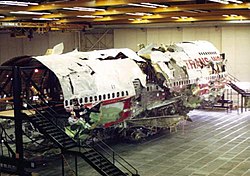US FAA to make airliner fuel tank inertion mandatory over 1996 air disaster
Thursday, July 17, 2008

The United States Federal Aviation Authority (FAA) has announced that inerting systems in airliner fuel tanks are to be made mandatory. The move, in conjunction with the U.S. Department of Transportation (DOT), is in response to a recommendation made by the country's National Transportation Safety Board (NTSB) as part of its investigation into a 1996 air disaster.
TWA Flight 800 was a Boeing 747 that exploded in mid-air twelve years ago today, on July 17, 1996, above the Atlantic Ocean. All 230 people on board the New York to Paris flight were killed as the aircraft disintegrated shortly after takeoff from John F. Kennedy International Airport. It was ultimately determined that center wing fuel tank had exploded after sparking faulty wiring ignited a volatile fuel-air mix in the tank.
After the investigation was completed the NTSB requested that the FAA enforce the requirement of inerting systems to prevent dangerous fuel-air mixes from being ignited. One of the most feasible ways of doing this is with nitrogen pumped into the tank, reducing the amount of oxygen available and making ignition difficult or impossible. The NTSB has a 'Most Wanted List of Transportation Safety Improvements' and inerting systems for airliners have been on the list since 2002.
Since TWA 800 there have also been similar explosions in Thailand and India, but both occurred on the ground and resulted in no fatalities.
The FAA's new directive requires all new aircraft from August 20 to have the equipment fitted. It also requires all carriers to retrofit their fleets, with half of their airliners to be compliant within six years and every jetliner in the US to have the technology fitted in nine years.
The FAA's announcement was made at the Virginia hangar where the remains of Flight 800 are stored.
Air carriers, who until now have fought against the changes, say that there will be a cost running into millions of dollars. If the nitrogen system is installed, the cost of retrofitting an airliner is at US$92,000 for mid-range jets such as the Boeing 737 and Airbus A320, and costs $311,000 for a Boeing 777 or other similar long-range widebodied airliner. The 747, which has a large center wing fuel tank, is especially vulnerable to such explosions.
Sources
- "12 years after air tragedy, new rules on fuel tanks" — Yahoo! News, July 17, 2008
- "FAA to announce new safety measures prompted by 1996 air crash" — Xinhua, July 17, 2008
- "FAA orders changes to airliner fuel systems" — CNN, July 17, 2008
- Press Release. "NTSB Commends FAA on Major Advancement in Aviation Safety" — National Transportation Safety Board, July 16, 2008
